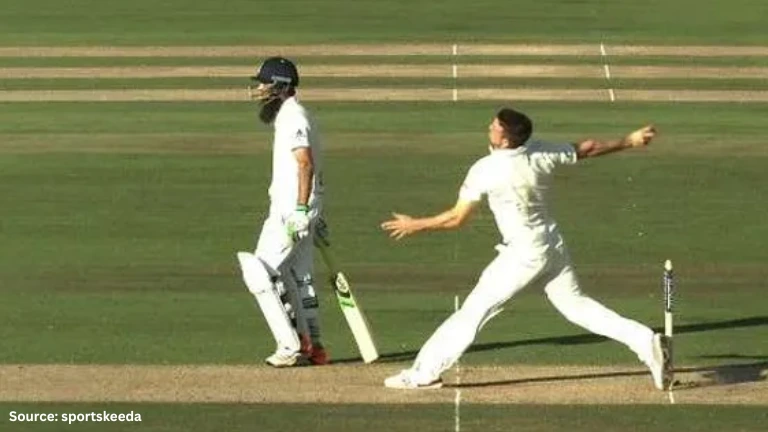Cricket is a sport full of rules and technical terms that can confuse beginners. One of the most commonly heard terms during a match is “no-ball.” But what exactly is a no-ball in cricket? Why does the umpire raise one hand sideways and stop the game? In this article, we’ll explain the concept of a no-ball in cricket using simple language and real match examples. Whether you’re a beginner, a cricket fan, or someone creating content around cricket, this guide will help you understand the basics clearly.
What is a No-Ball in Cricket?
A no-ball in cricket is an illegal delivery by the bowler. When a bowler fails to follow the rules while delivering the ball, the umpire calls it a no-ball. This gives the batting team an advantage: they receive one extra run, and in limited-overs formats like ODIs and T20s, the next ball becomes a free hit. A no-ball can happen due to many reasons – overstepping the line, bowling a dangerous ball, or using an illegal bowling action.
The umpire signals a no-ball by extending one arm straight out to the side. This signal is recognized by players and fans alike.
Simple Examples of a No-Ball in Cricket
Let’s look at some real-life scenarios to understand how no-balls occur in a match.
Table of Contents
1. Overstepping the Front Line (Popping Crease)
This is the most common reason for a no-ball. The bowler’s front foot must land behind or on the popping crease when delivering the ball. If the bowler’s foot crosses the line entirely, it’s called a front-foot no-ball.
Example: In a fast-paced match, a bowler trying to generate extra speed oversteps slightly. The umpire notices and immediately calls a no-ball.
2. High Full Toss (Waist-High Delivery)
If a bowler delivers a ball that reaches the batter above the waist without bouncing, it is considered dangerous. This is called a waist-high no-ball or high full toss, and it can injure the batter.
Example: A bowler accidentally bowls a full toss that reaches the batter at chest level. The umpire calls a no-ball for safety reasons.
3. Multiple Bouncers in One Over
According to modern cricket rules, only one short-pitched bouncer is allowed per over. If the bowler bowls a second bouncer that passes above shoulder height, it is considered a no-ball.
Example: A fast bowler tries to intimidate the batter by bowling two bouncers in an over. The second one goes over the batter’s head. The umpire declares a no-ball.
4. Illegal Bowling Action
If a bowler’s arm straightens more than 15 degrees during the delivery (often called chucking), it is considered an illegal action, and the delivery is a no-ball.
Example: During a match, the third umpire checks replays and finds the bowler’s elbow bend exceeds the limit. The delivery is ruled as a no-ball.
5. Back-Foot No-Ball
Although rare today, if the bowler’s back foot touches or crosses the return crease (the side line), it can be called a back-foot no-ball.
What Happens After a No-Ball in Cricket?
Now that we know what causes a no-ball, let’s look at the outcomes. A no-ball gives the batting team an opportunity to score more runs.
Key Outcomes:
- One extra run is awarded to the batting team.
- The bowler must deliver an extra ball, as the no-ball does not count in the over.
- In limited-overs formats, the next delivery becomes a free hit. This means the batter cannot be dismissed in most ways (except run-out or obstruction).
- The fielding team is not allowed to change the field for the free hit unless the striker changes ends.
This rule gives the batting side a huge advantage, especially in the final overs of a match.
Types of No-Ball in Cricket
There are various types of no-ball in cricket, each with different reasons behind it. Here’s a breakdown of the most common ones:
- Front-Foot No-Ball – Overstepping the popping crease.
- High Full Toss No-Ball – Ball above the batter’s waist without bouncing.
- Back-Foot No-Ball – Back foot crossing the return crease.
- Bouncer No-Ball – More than one bouncer per over in ODIs/T20s.
- Illegal Bowling Action No-Ball – Arm bending beyond 15 degrees.
- Underarm No-Ball – Throwing the ball underarm (not allowed in modern cricket).
Umpires closely monitor bowlers and use technology to ensure these rules are followed during international matches.
No-Ball Rules in One Day Cricket
In One Day Internationals (ODIs), the rules for no-balls are strict. Technology such as front-foot sensors and third umpires is often used to catch even the slightest overstep.
Important Rules:
- Every no-ball gives the batter a free hit.
- Dangerous deliveries are penalized strictly, especially if bowled above waist height.
- Teams that bowl too many no-balls may face fines or over-rate penalties.
Umpires are encouraged to keep player safety in mind, especially in ODIs and T20s.
How to Identify a No-Ball in a Cricket Match
If you’re watching a match and want to understand why the umpire signaled a no-ball, here are a few tips:
- Watch the bowler’s front foot. If it crosses the line, expect a no-ball.
- If a high full toss reaches the batter’s waist, the umpire will call it.
- Listen for the umpire’s call and observe the signal – one arm extended sideways.
- Replays often show slow-motion visuals of the bowler’s foot to confirm no-balls.
With experience, viewers start recognizing no-balls even before the umpire signals.
Difference Between No-Ball and Wide Ball in Cricket
A no-ball and a wide ball are both illegal deliveries, but they are different in nature.
No-Ball:
- Caused by illegal foot placement, high full toss, or dangerous bowling.
- Often results in a free hit (in ODIs and T20s).
- Adds one run to the batting team’s total.
Wide Ball:
- Bowled outside the batter’s reach, usually too far on the off-side or leg-side.
- No free hit is awarded.
- Also adds one run to the batting team, and the ball must be re-bowled.
Both rules aim to ensure fair play and safety but are triggered by different causes.
Final Thoughts
Understanding what a no-ball in cricket is can help you enjoy the game better. It’s a simple yet important part of cricket’s rules, and it often changes the course of a match. Whether you’re a player, a viewer, or a blogger writing about cricket, knowing the types of no-balls and their effects will give you deeper insight into the game.
As you continue exploring the game of cricket, you’ll come across many such rules that shape the sport’s unique character. For new cricket blogs, starting with such beginner-friendly topics is a great way to attract and educate your audience.


